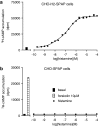A study of antagonist affinities for the human histamine H2 receptor
- PMID: 18157166
- PMCID: PMC2267271
- DOI: 10.1038/sj.bjp.0707644
A study of antagonist affinities for the human histamine H2 receptor
Abstract
Background and purpose: Ligand affinity has been a fundamental concept in the field of pharmacology and has traditionally been considered to be constant for a given receptor-ligand interaction. Recent studies have demonstrated that this is not true for all three members of the G(s)-coupled beta-adrenoceptor family. This study evaluated antagonist affinity measurements at a different G(s)-coupled receptor, the histamine H(2) receptor, to determine whether antagonist affinity measurements made at a different family of GPCRs were constant.
Experimental approach: CHO cells stably expressing the human histamine H(2) receptor and a CRE-SPAP reporter were used and antagonist affinity was assessed in short-term cAMP assays and longer term CRE gene transcription assays.
Key results: Nine agonists and seven antagonists, of sufficient potency at the H(2) receptor to examine in detail, were identified. Measurements of antagonist affinity were the same regardless of the efficacy of the competing agonist, time of agonist incubation, cellular response measured or presence of a PDE inhibitor.
Conclusions and implications: Antagonist affinity at the G(s)-coupled histamine H(2) receptor obeys the accepted dogma for antagonism at GPCRs. This study further confirms that something unusual is indeed happening with the beta-adrenoceptors and is not an artefact related to the transfected cell system used. As the human histamine H(2) receptor does not behave in a similar manner to any of the human beta-adrenoceptors, it is clear that information gathered from one GPCR cannot be simply extrapolated to predict the behaviour of another GPCR. Each GPCR therefore requires careful and detailed evaluation on its own.
Figures






Comment in
-
What systems can and can't do.Br J Pharmacol. 2008 Mar;153(5):841-3. doi: 10.1038/sj.bjp.0707677. Epub 2008 Jan 21. Br J Pharmacol. 2008. PMID: 18204481 Free PMC article.
Similar articles
-
Antagonist affinity measurements at the Gi-coupled human histamine H3 receptor expressed in CHO cells.BMC Pharmacol. 2008 Jun 6;8:9. doi: 10.1186/1471-2210-8-9. BMC Pharmacol. 2008. PMID: 18538007 Free PMC article.
-
Effects of N-alpha-methyl-histamine on human H(2) receptors expressed in CHO cells.Gut. 2002 Jun;50(6):786-9. doi: 10.1136/gut.50.6.786. Gut. 2002. PMID: 12010879 Free PMC article.
-
Pharmacological characterization of the human histamine H2 receptor stably expressed in Chinese hamster ovary cells.Br J Pharmacol. 1994 Jul;112(3):847-54. doi: 10.1111/j.1476-5381.1994.tb13157.x. Br J Pharmacol. 1994. PMID: 7921611 Free PMC article.
-
Defining the histamine H2-receptor in brain: the interaction with LSD.NIDA Res Monogr. 1978;(22):38-59. NIDA Res Monogr. 1978. PMID: 30911 Review.
-
Pharmacological properties of histamine receptor subtypes.Cell Mol Biol (Noisy-le-grand). 1994 May;40(3):275-81. Cell Mol Biol (Noisy-le-grand). 1994. PMID: 7920174 Review.
Cited by
-
Histamine modulates γδ-T lymphocyte migration and cytotoxicity, via Gi and Gs protein-coupled signalling pathways.Br J Pharmacol. 2010 Nov;161(6):1291-300. doi: 10.1111/j.1476-5381.2010.00639.x. Br J Pharmacol. 2010. PMID: 20977468 Free PMC article.
-
International Union of Basic and Clinical Pharmacology. XCVIII. Histamine Receptors.Pharmacol Rev. 2015 Jul;67(3):601-55. doi: 10.1124/pr.114.010249. Pharmacol Rev. 2015. PMID: 26084539 Free PMC article. Review.
-
Antagonist affinity measurements at the Gi-coupled human histamine H3 receptor expressed in CHO cells.BMC Pharmacol. 2008 Jun 6;8:9. doi: 10.1186/1471-2210-8-9. BMC Pharmacol. 2008. PMID: 18538007 Free PMC article.
-
The Roles of Cardiovascular H2-Histamine Receptors Under Normal and Pathophysiological Conditions.Front Pharmacol. 2021 Dec 20;12:732842. doi: 10.3389/fphar.2021.732842. eCollection 2021. Front Pharmacol. 2021. PMID: 34987383 Free PMC article. Review.
-
Novel selective β1-adrenoceptor antagonists for concomitant cardiovascular and respiratory disease.FASEB J. 2017 Jul;31(7):3150-3166. doi: 10.1096/fj.201601305R. Epub 2017 Apr 11. FASEB J. 2017. PMID: 28400472 Free PMC article.
References
-
- Baker JG. Sites of action of β-ligands at the human β1-adrenoceptor. J Pharmacol Exp Ther. 2005a;313:1163–1171. - PubMed
-
- Baker JG. Evidence for a secondary state of the human β3-adrenoceptor. Mol Pharmacol. 2005b;68:1645–1655. - PubMed
-
- Baker JG, Hall IP, Hill SJ. Agonist actions of ‘β-blockers' provide evidence for two agonist activation sites or conformations of the human β1-adrenoceptor. Mol Pharmacol. 2003a;63:1312–1321. - PubMed
Publication types
MeSH terms
Substances
Grants and funding
LinkOut - more resources
Full Text Sources
Molecular Biology Databases
Research Materials

